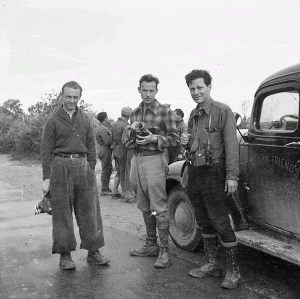Rare Documentary Film Saved
A year ago, film researcher Juan Salas made the startling discovery that a 16mm print of documentary footage in the ALBA Collection of the Tamiment Library was the long lost film made by Henri Cartier-Bresson during the Spanish Civil War, titled With the Abraham Lincoln Brigade in Spain. The discovery prompted the decision to preserve it. This collaborative effort was carried on by the Barbara Goldsmith Preservation and Conservation Department at NYU Libraries.
Preserving a motion picture film means creating new film elements from original existing ones in an effort to prolong its life and make it as widely available as possible. Every effort is made to be faithful to the visual quality and content of the original film, which are determining factors in the preservation strategy. The duplication process used in film-to-film preservation always implies generation loss and therefore an alteration of the image quality. The closer to the original elements one is able to work, the higher the image quality. The surviving print was in poor physical condition, multiple generations away from the original negative, and could not be projected. An exhaustive investigation began to locate better elements from which to do preservation.
To find any existing film elements and information useful for the preservation work, repositories thought most likely to have a connection to the film were contacted, including the Henri Cartier-Bresson Foundation in Paris and the Filmoteca Española in Madrid, as well as a wider selection of international archives and organizations. After months of research, no camera original negative was discovered. However, additional prints were found. Upon inspection and comparison of these prints (of varying lengths and quality), the best print to use for the preservation work was identified.
One of the challenges in preservation is not to rush this process until all possible existing elements can be located and to determine when to stop the research if the original camera negative remains undiscovered. This can be difficult to achieve when there are specific deadlines to meet, such as an opportunity to show the film, which, in turn, can lead to funding to carry out the preservation work, as was the case with the Henri Cartier-Bresson film. The funding for preservation was secured in the form of a donation of work by a New York lab, Cineric, a sponsor of the Seventh Orphan Film Symposium, where the film will screen in April 2010.
The lab work consisted of making a 35mm duplicate negative using an optical printer that re-photographs the 16mm print onto 35mm film. From that negative, a new 35mm print was struck. Because the film is silent, there was no sound to preserve. The decision was made to blow up the 16mm print to 35mm because that was the original format of the film. Additionally, given the preponderance of 35mm projection facilities, this choice will increase the film’s future screening opportunities. Finally, a transfer of the 35mm film to Digital Betacam and DVDs will also facilitate wider access possibilities.
Alice Moscoso is the Moving Image Preservation Specialist at the NYU Libraries.















